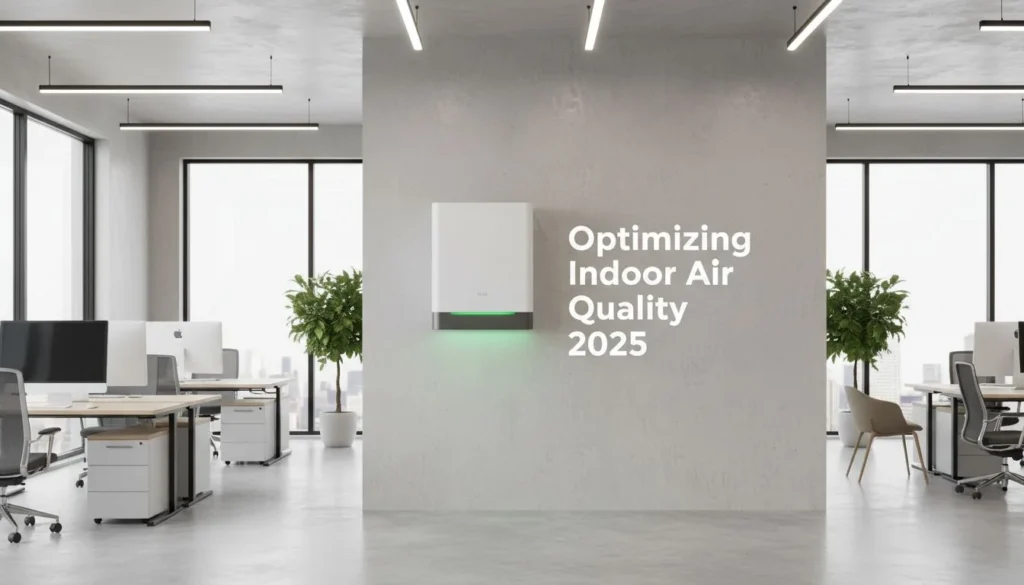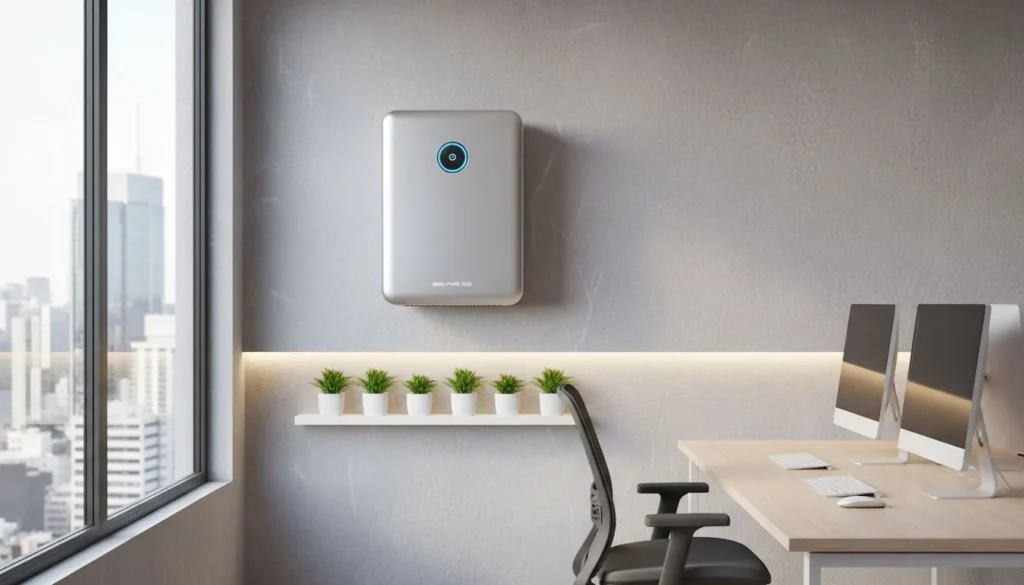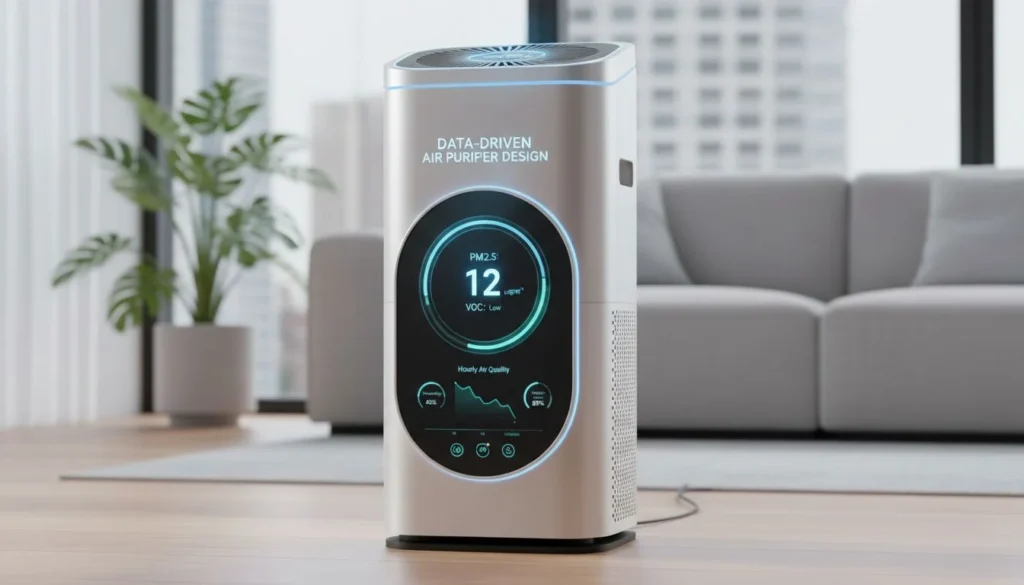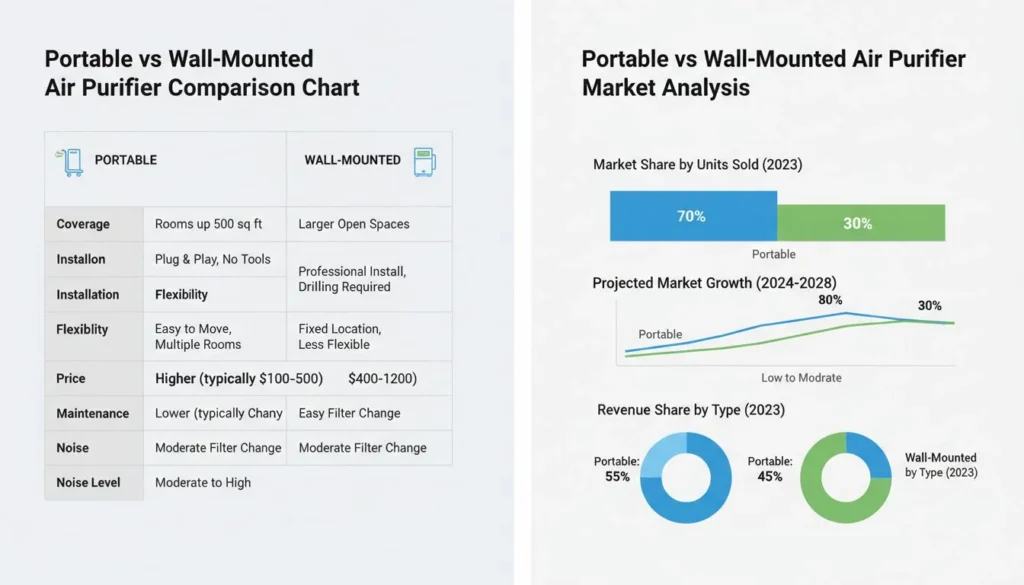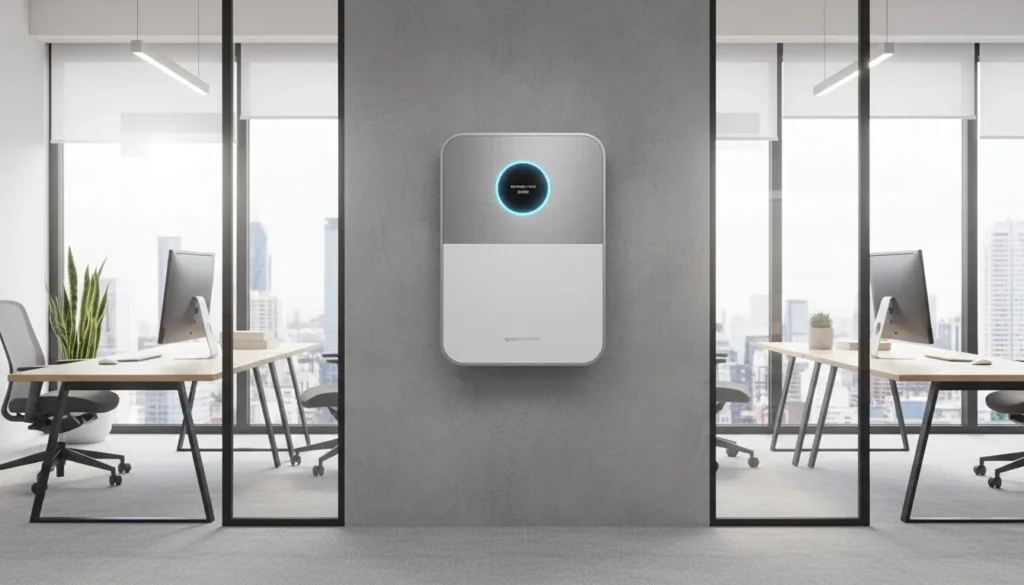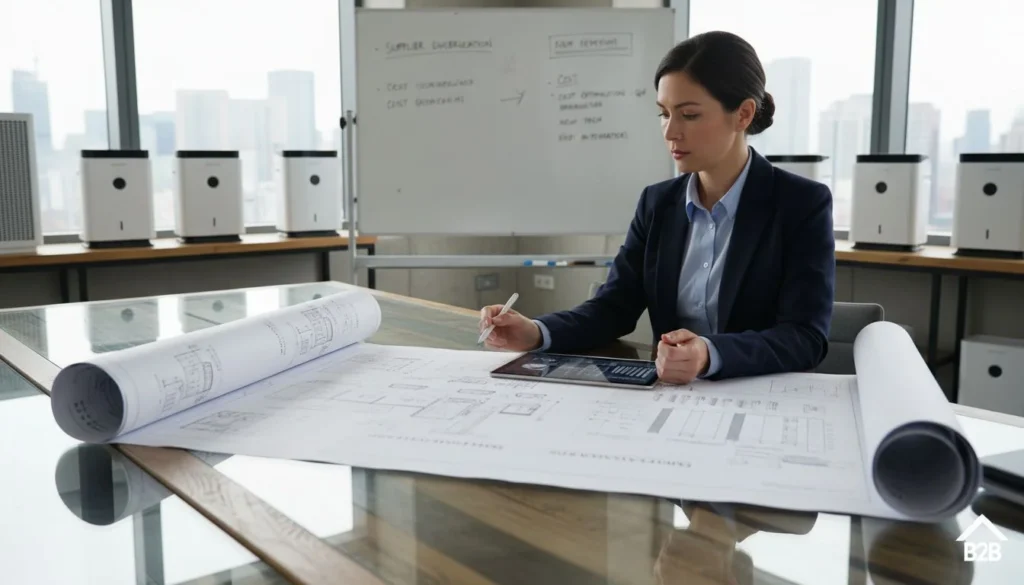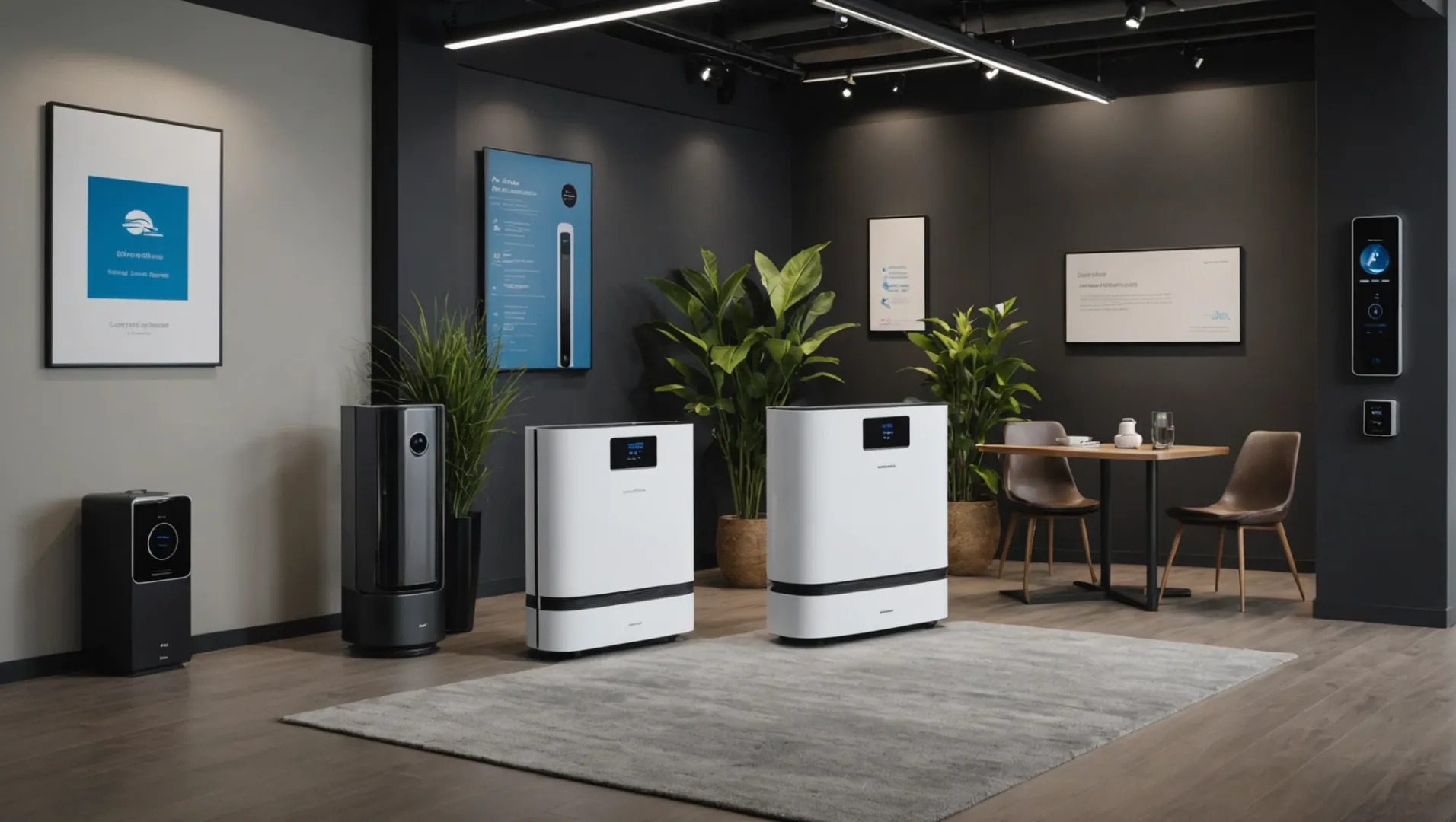
더 깨끗한 공기를 찾는 과정에서 공기청정기를 가장 저렴하게 구입하는 방법은 단순히 가격표만 보는 것이 아니라는 것을 알게 되었습니다. 그 숫자 아래에 무엇이 숨어 있는지 이해하는 것이 중요합니다.
다양한 공급업체의 공기청정기 가격을 효과적으로 비교하려면 다음과 같은 주요 기능에 집중하세요. CADR, 소음 수준, 필터 유형 등을 고려하세요. 비용과 성능을 모두 고려하여 공정한 비교를 위해 유사한 사양을 평가해야 합니다.
가격도 중요하지만, 공기청정기 기능의 미묘한 차이를 파악하는 것이 구매 결정의 성패를 좌우할 수 있습니다. 저와 함께 무엇이 정말 중요한지 알아보세요!
CADR은 비교해야 할 가장 중요한 기능입니다.True
CADR은 성능 평가에 중요한 공기청정기 효율을 측정합니다.
공기청정기를 비교할 때 어떤 기능을 중점적으로 살펴봐야 할까요?
올바른 공기청정기를 선택하려면 성능과 가치에 영향을 미치는 특정 기능에 세심한 주의를 기울여야 합니다.
공기청정기를 비교할 때는 다음 사항에 중점을 두십시오. CADR소음 수준, 필터 유형 및 추가 스마트 기능을 통해 최적의 공기질과 사용자 편의성을 보장합니다.
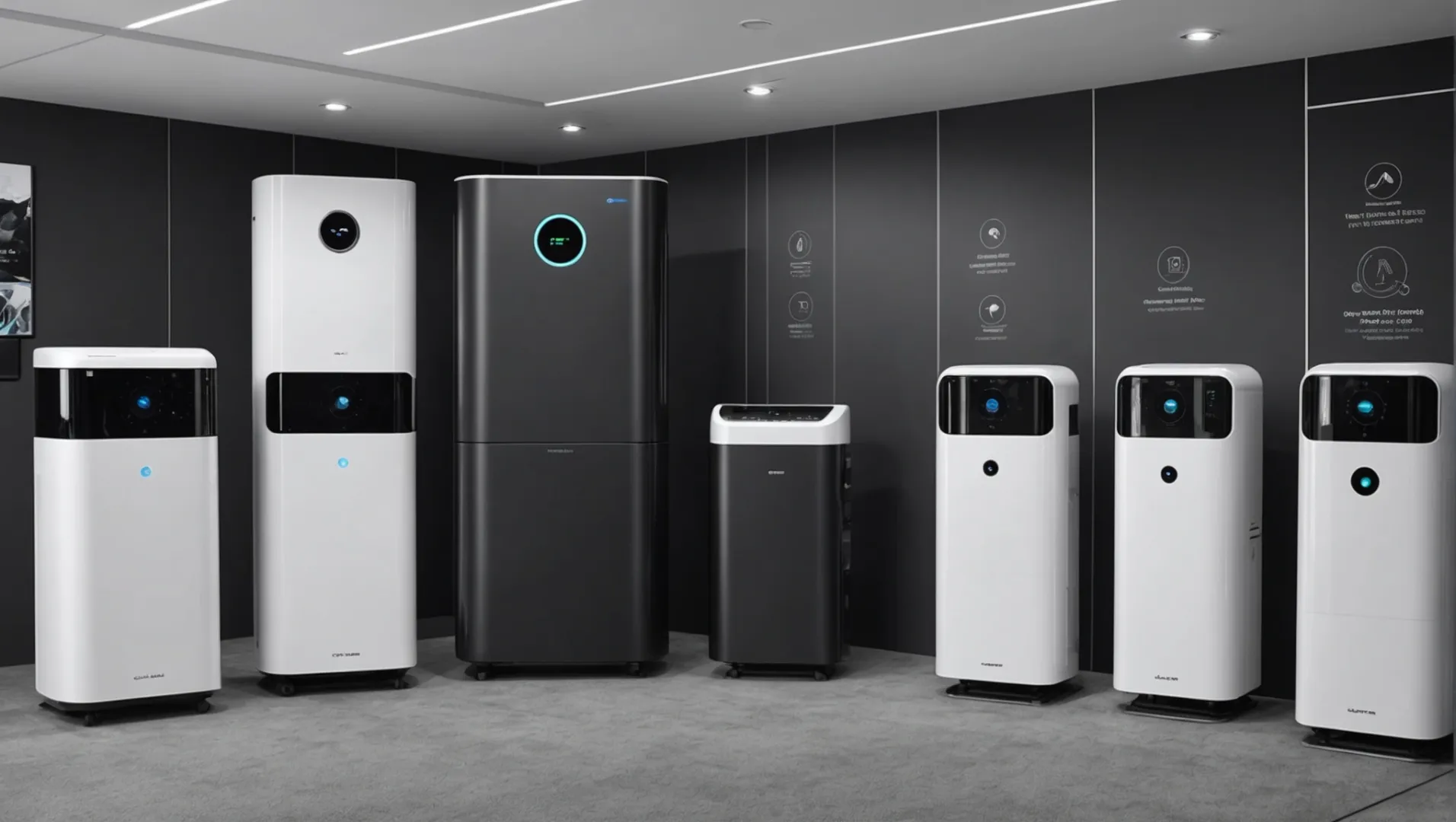
이해 CADR 그리고 그 중요성
깨끗한 공기 전달률 (CADR)는 공기청정기를 평가할 때 중요한 측정값입니다. 이는 공기청정기가 분당 생성하는 필터링된 공기의 양을 나타내며, 공기청정기가 실내를 얼마나 효율적으로 청소하는지에 영향을 미칩니다. 수치가 높을수록 CADR 값은 더 빠른 공기 정화를 의미합니다.
비교 CADR 값을 비교하면 비슷한 공간 크기 사양의 모델에서 어떤 기기가 더 나은 성능을 제공하는지 평가할 수 있습니다. 기억하세요, 일치하는 CADR1 를 방 크기에 맞게 조정하는 것이 효과적인 정화를 위해 필수적입니다.
노이즈 수준 평가
특히 침실이나 사무실에서 공기청정기를 사용하는 경우 소음 수준이 편안함에 큰 영향을 미칠 수 있습니다. 제조업체에서 제공하는 데시벨 수준을 확인하세요. 제공 모델 데시벨 캔슬링 기술2 는 더 조용하게 작동하여 방해되는 소음 없이 환경을 개선할 수 있습니다.
| 모델 | 소음 수준(dB) |
|---|---|
| 모델 A | 40dB |
| 모델 B | 50dB |
| 모델 C | 35dB |
필터 유형 고려
필터의 종류는 공기청정기가 제거할 수 있는 오염 물질에 중추적인 역할을 합니다. 일반적인 필터는 다음과 같습니다. HEPA활성탄, 자외선 필터가 있습니다. 각각 다른 용도로 사용됩니다:
- HEPA 필터: 꽃가루, 먼지, 연기 등 0.3마이크론 크기의 입자를 포착합니다.
- 활성탄 필터: 냄새와 기체 오염 물질을 제거하세요.
- 자외선 필터: 박테리아와 바이러스를 죽이세요.
평가 어떤 필터 유형3 알레르기를 줄이거나 냄새를 없애는 등 특정 요구 사항에 맞게 조정할 수 있습니다.
추가 스마트 기능
최신 공기청정기에는 원격 제어, 센서 기반 조정, 홈 자동화 시스템과의 통합을 위한 IoT 기능과 같은 스마트 기능이 탑재되어 있습니다. 실시간 공기질 모니터링이나 앱 제어와 같은 기능은 상당한 편의성과 기능을 제공할 수 있습니다.
다음 사항을 고려하십시오. 스마트 기능4 는 라이프스타일에 필수적이며 전반적인 사용성과 효율성을 향상시킬 수 있습니다.
CADR이 높을수록 공기 정화 속도가 빨라집니다.True
CADR은 분당 필터링된 공기의 양을 측정하여 속도에 영향을 줍니다.
HEPA 필터는 공기 중의 냄새를 제거합니다.False
HEPA 필터는 작은 입자를 포착하지만 냄새를 제거하지는 못합니다.
공급업체별 기술을 평가하는 것이 중요한 이유는 무엇인가요?
공급업체가 제공하는 고유한 기술을 이해하면 구매 결정에 큰 영향을 미칠 수 있습니다.
공급업체별 기술을 평가하는 것은 제품 품질, 비용 효율성 및 혁신에 영향을 미치기 때문에 매우 중요합니다. 이러한 고유한 제품을 이해함으로써 귀사의 요구와 비즈니스 목표에 부합하는 정보에 입각한 결정을 내릴 수 있습니다.

고유한 기술 제품 이해
공기청정기를 비교할 때는 초기 비용이나 다음과 같은 표준 기능만 고려하는 것이 아닙니다. CADR (청정 공기 전달률) 및 소음 수준. 공급업체별 기술은 한 제품을 다른 제품과 차별화하는 고유한 이점을 제공할 수 있습니다. 예를 들어 HisoAir의 데시벨 캔슬레이션 기술은 소음을 크게 줄여 조용한 작동을 우선시하는 고객에게 결정적인 요소가 될 수 있습니다. 이러한 혁신은 부가 가치로 인해 더 높은 가격대를 정당화할 수 있습니다.
비용 효율성에서 혁신의 역할
공급업체의 혁신은 종종 더 비용 효율적인 솔루션으로 이어집니다. 스톰 모터 기술과 같은 기술은 효율성을 향상시켜 에너지 소비를 줄이고 장기적인 운영 비용을 낮출 수 있습니다. 이러한 혁신을 평가함으로써 기업은 초기 투자가 시간이 지남에 따라 비용 절감으로 이어질지 여부를 결정할 수 있습니다. 다음과 같은 사항을 고려하는 것이 중요합니다. 기술적 이점5 를 가격 대비 비교하여 현명한 투자를 보장합니다.
강력한 공급업체 관계 구축
공급업체별 기술을 이해하고 활용하면 더욱 강력한 파트너십을 구축할 수 있습니다. 공급업체가 귀사의 혁신을 높이 평가한다는 사실을 알게 되면 특히 다음과 같은 분야에서 더 나은 가격 협상과 협업으로 이어질 수 있습니다. ODM (오리지널 디자인 제조업체) 프로젝트. 자재 명세서 요청하기(BOM)를 통해 대량으로 처리할 때 공급업체의 비용을 투명하게 비교하고 고유한 기술적 이점을 강조할 수 있습니다.
| 기능 | 공급업체 A | 공급업체 B |
|---|---|---|
| CADR | 300m³/h | 280m³/h |
| 소음 수준 | 45dB | 50dB |
| 데시벨 취소 | 예 | 아니요 |
| 필터 유형 | HEPA | 탄소 |
| 혁신적인 모터 기술 | 예 | 아니요 |
경쟁 우위 확보
마지막으로, 이러한 기술을 평가하면 공급망의 경쟁력을 유지할 수 있습니다. 우수한 기술을 보유한 공급업체는 더 나은 성능이나 고유한 기능을 제공하는 제품을 제공하여 시장에서 우위를 점할 수 있습니다. 이러한 경쟁 우위는 고객 만족을 유지하고 장기적인 비즈니스 성공을 달성하는 데 매우 중요합니다.
공급업체별 기술에 집중함으로써 제품 제공을 향상시킬 뿐만 아니라 시장에서의 입지를 강화할 수 있습니다.
공급업체별 기술을 통해 운영 비용을 절감할 수 있습니다.True
스톰 모터 기술과 같은 혁신으로 효율성을 높이고 비용을 절감할 수 있습니다.
공급업체 기술 평가는 제품 품질에 영향을 미치지 않습니다.False
이러한 기술을 이해하는 것은 품질, 비용 효율성 및 혁신에 영향을 미칩니다.
총 비용이 공기청정기 구매 결정에 어떤 영향을 미치나요?
공기청정기를 선택할 때는 초기 가격뿐만 아니라 총 비용을 고려하는 것이 중요합니다.
공기청정기의 총 비용에는 구매 가격, 유지 관리 비용, 운영 비용이 포함됩니다. 이러한 모든 요소를 평가하여 장기적으로 예산에 맞는 모델을 선택해야 공기질에 대한 요구 사항을 충족할 수 있습니다.
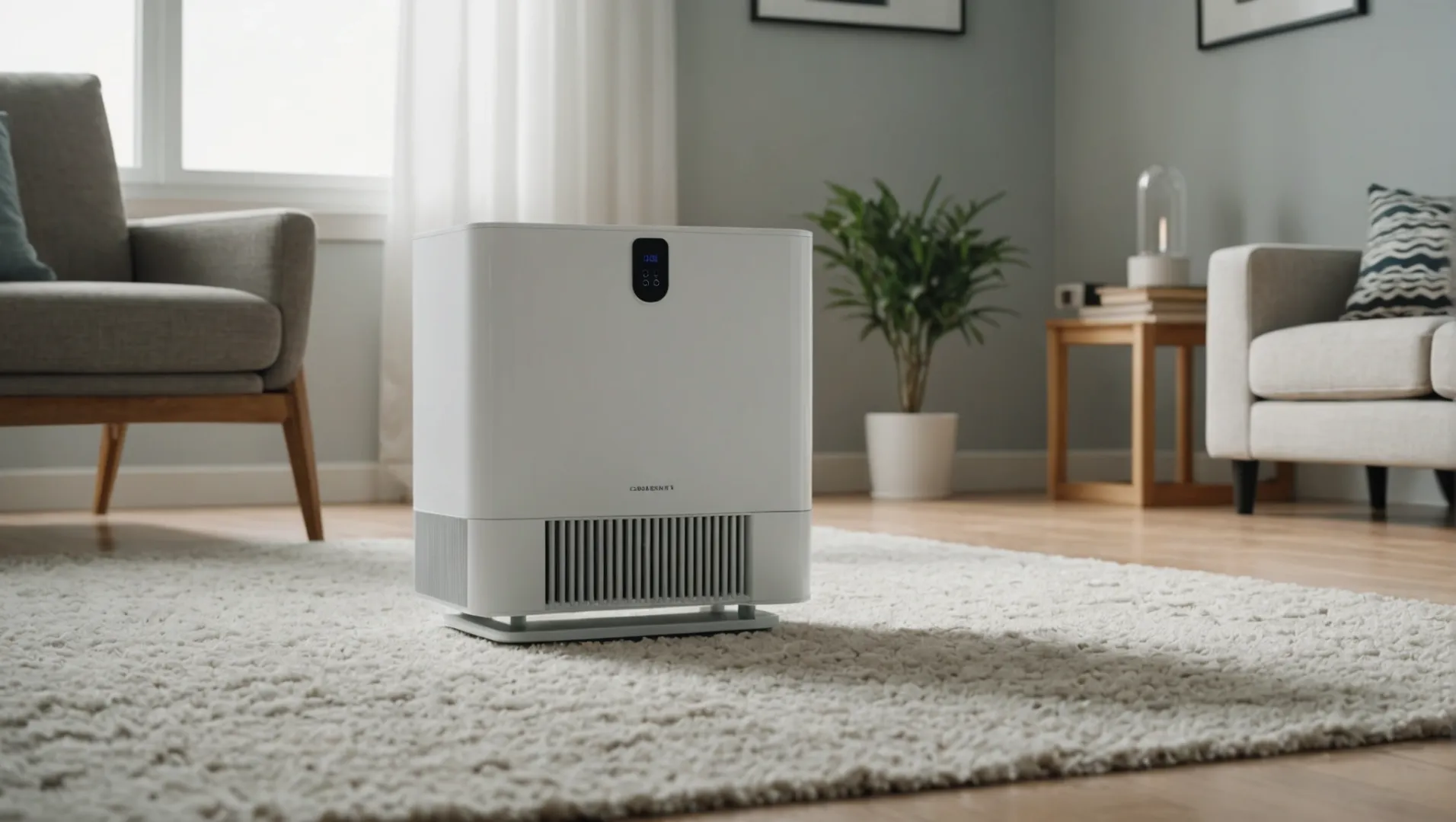
총 비용 구성 요소 이해
공기청정기를 평가할 때는 세 가지 주요 비용 요소를 고려하세요:
- 초기 구매 가격: 공기청정기를 소유하기 위해 지불하는 선불 비용입니다. 다음과 같은 기능에 따라 크게 달라집니다. CADR (청정 공기 전달률), 소음 수준 및 필터 유형에 따라 달라집니다. 높을수록 CADR 는 더 높은 가격을 의미할 수도 있지만, 더 나은 성능을 의미하기도 합니다.
- 유지 관리 비용: 최적의 성능을 위해서는 정기적인 유지 관리가 중요합니다. 필터 교체 비용은 정수기 제조사와 모델에 따라 크게 달라질 수 있습니다. 일부 모델은 교체 대신 청소가 필요한 영구 필터를 제공하므로 시간이 지남에 따라 비용을 절약할 수 있습니다.
- 운영 비용: 여기에는 전기 소비량도 포함됩니다. 에너지 효율이 높은 모델은 초기 비용이 더 높을 수 있지만 장기적으로는 에너지 요금을 줄여 비용을 절감할 수 있습니다.
공급업체별 기술의 역할
일부 공급업체는 총 비용에 영향을 줄 수 있는 고유한 기술을 제공합니다. 예를 들어 HisoAir의6 데시벨 캔슬레이션 기술은 소음을 줄일 뿐만 아니라 에너지 소비를 줄이는 데도 기여할 수 있습니다. 마찬가지로 스톰 모터 기술은 공기 흐름의 효율성을 향상시켜 운영 비용을 낮출 수 있습니다.
시간 경과에 따른 비용 평가의 중요성
총 비용을 평가하려면 당장의 비용 외에도 여러 가지를 고려해야 합니다. 구매 가격은 저렴하지만 유지 관리 비용이 높은 모델은 유지 관리가 거의 필요 없는 고가의 대안에 비해 장기적으로 더 비쌀 수 있습니다.
| 비용 구성 요소 | 고려 사항 예시 |
|---|---|
| 초기 구매 가격 | 다음과 같은 기능 CADR, IoT 기능 및 센서 유형 |
| 유지 관리 비용 | 필터 교체 주기 및 비용 |
| 운영 비용 | 에너지 소비 및 효율 등급 |
더 나은 공급업체 협상을 위한 총비용 활용
주문량이 많거나 다음과 관련된 경우 ODM 프로젝트를 요청하여 BOM (자재 명세서) 목록을 공급업체로부터 받는 것이 유리할 수 있습니다. 이러한 투명성을 통해 보다 공격적이고 정보에 입각한 가격 협상을 할 수 있습니다.
이러한 요소를 종합적으로 평가하여 예산과 공기질 목표에 맞는 공기청정기를 선택하면 궁극적으로 더 만족스러운 구매 경험을 할 수 있습니다.
CADR이 높을수록 공기청정기의 성능이 우수함을 나타냅니다.True
CADR은 공기청정기의 오염물질 제거 효율을 측정합니다.
영구 필터는 항상 교체 가능한 필터보다 가격이 비쌉니다.False
영구 필터는 교체가 아닌 청소만 하면 되므로 시간이 지남에 따라 비용을 절약할 수 있습니다.
비교 과정에서 리뷰와 평점은 어떤 역할을 하나요?
분주한 공기청정기 시장에서 리뷰와 평가는 현명한 구매 결정의 길을 밝혀주는 길잡이 역할을 합니다.
리뷰와 평가는 직접적인 사용자 경험과 전문가 인사이트를 제공하여 제품의 신뢰성과 성능을 측정하는 데 도움을 줍니다. 일반적인 문제와 이점을 강조하여 정보에 입각한 의사 결정 과정을 보장합니다.

사용자 피드백의 영향력 이해하기
오늘날의 디지털 시대에 리뷰와 평점은 구매 프로세스에서 필수적인 요소가 되었습니다. 이미 제품을 사용해 본 사람들의 진정한 인사이트를 제공합니다. 이를 고려하면 공기청정기의 실제 성능과 잠재력을 보다 명확하게 이해할 수 있습니다. 이슈7및 뛰어난 기능을 제공합니다.
리뷰 유형: 사용자 대 전문가
-
사용자 리뷰: 일상적인 사용자들의 진솔한 피드백을 제공합니다. 사용 편의성, 유지 관리 문제, 고객 서비스 경험 등 실용적인 측면을 강조하는 경우가 많습니다.
-
전문가 리뷰: 기술 또는 소비자 웹사이트에서 흔히 볼 수 있는 이러한 리뷰는 기술 사양을 자세히 살펴보고 유사한 모델과의 비교를 제공합니다. 다음과 같은 측면을 살펴볼 수 있습니다. CADR8 를 클릭하고 수명을 더 자세히 필터링하세요.
비판적으로 리뷰 평가하기
모든 리뷰가 똑같이 작성되는 것은 아닙니다. 일부는 편향적이거나 인센티브가 제공될 수 있습니다. 따라서 다음을 수행하는 것이 중요합니다:
- 패턴 찾기: 여러 리뷰에서 빌드 품질이 좋지 않거나 작동 시 소음이 발생한다고 언급하는 경우, 이는 정당한 우려일 수 있습니다.
- 소스 확인: 리뷰 플랫폼의 신뢰성을 확인하세요. 신뢰할 수 있는 출처에는 긍정적인 피드백과 부정적인 피드백이 섞여 있는 경우가 많습니다.
등급: 간단한 개요
평점은 고객 만족도를 한눈에 파악할 수 있습니다. 일반적으로 높은 평점을 받은 제품은 신뢰성과 효율성을 나타냅니다. 하지만
- 평점 수를 고려하세요. 10명의 사용자로부터 받은 별점 5개는 천 명의 사용자로부터 받은 별점 1개보다 신뢰도가 떨어집니다.
- 피드백이 현재 공기청정기의 모델 또는 버전을 반영하는지 확인하려면 최근 평점을 확인하세요.
의사 결정에 평판 활용하기
다른 공급업체와 비교하는 것이므로 A 공급업체에게 B 공급업체와 가격과 품질을 비교하고 있다고 말하면 공급업체에 압력을 주어 더 나은 가격을 받을 수 있다는 팁을 알려줄 수 있습니다. 그러나 의사 결정을 위해서는 잠재적인 공급업체 평판에 대한 정보를 수집해야 위험을 낮출 수 있습니다.
결론
비용과 품질 및 기술을 비교하여 공기질에 대한 요구 사항을 충족하는 스마트한 구매를 보장합니다.
-
CADR을 실내 크기에 맞춰 최적의 공기 정화를 보장합니다: 이 문서에서는 공기청정기의 적절한 크기를 파악하기 위한 세 가지 필수 단계와 CADR이라는 지표가 이를 어떻게 도울 수 있는지에 대해 설명합니다. ↩
-
더 조용한 공기청정기 작동을 위한 기술에 대해 알아보세요: HiSo 공기청정기는 데시벨 캔슬레이션™ 기술을 사용하여 밀도가 낮은 필터를 사용할 수 있습니다. 충전 된 입자가 더 쉽게 부착되어 필요성이 줄어 듭니다 ... ↩
-
필요에 가장 적합한 필터 유형을 식별하는 데 도움이 됩니다: 공기 필터에는 어떤 종류가 있나요? - 헤파 필터 - 자외선 필터 - 정전기 필터 - 빨 수 있는 필터 - 미디어 필터 - 스펀 유리 필터 ... ↩
-
스마트 기능이 공기청정기의 사용성을 어떻게 향상시킬 수 있는지 알아보세요: 하지만 잘 설계된 공기청정기는 박테리아, 바이러스뿐만 아니라 꽃가루, 곰팡이 포자 등 거의 모든 공기 중 알레르겐을 포집할 수 있습니다 ... ↩
-
혁신으로 비용을 절감하고 공기 청정기 효율을 개선하는 방법을 알아보세요: 이 혁신적인 접근 방식은 나노 입자 크기에서 더 큰 크기까지 최대 99%까지 입자상 물질을 동시에 감소시키고 제거할 뿐만 아니라 ... ↩
-
이 기술이 어떻게 소음을 줄이고 에너지를 절약하는지 알아보세요: HiSo 공기청정기는 데시벨 캔슬레이션™ 기술을 활용하여 밀도가 낮은 필터를 사용할 수 있습니다. 충전 된 입자가 더 쉽게 부착되어 필요성이 줄어 듭니다 ... ↩
-
공기청정기를 구매하기 전에 잠재적인 함정을 알아보세요..: 부적절하게 관리된 공기청정기는 필터가 더럽거나 막히거나 모터가 오작동하는 등 전반적인 기능에 영향을 미치는 문제가 발생할 수 있습니다. ↩
-
공기청정기 효율에 CADR이 중요한 이유 알아보기 ..: CADR 등급이 높은 공기청정기를 선택하면 먼지, 꽃가루, 연기 등의 오염 물질을 효과적으로 정화할 수 있습니다. ↩


